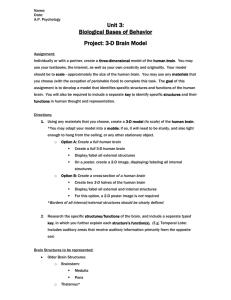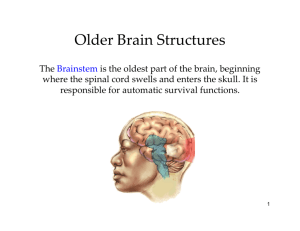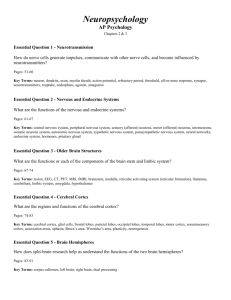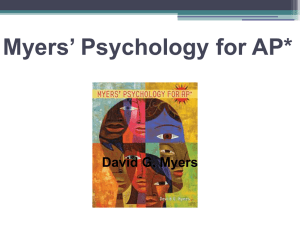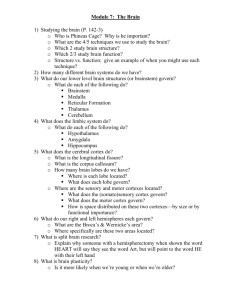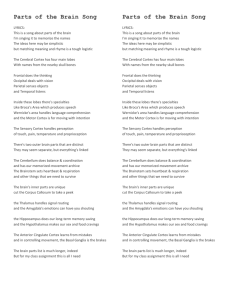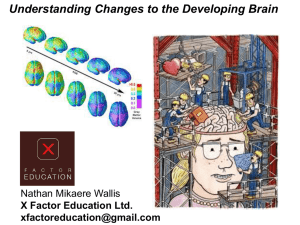1st Quarter
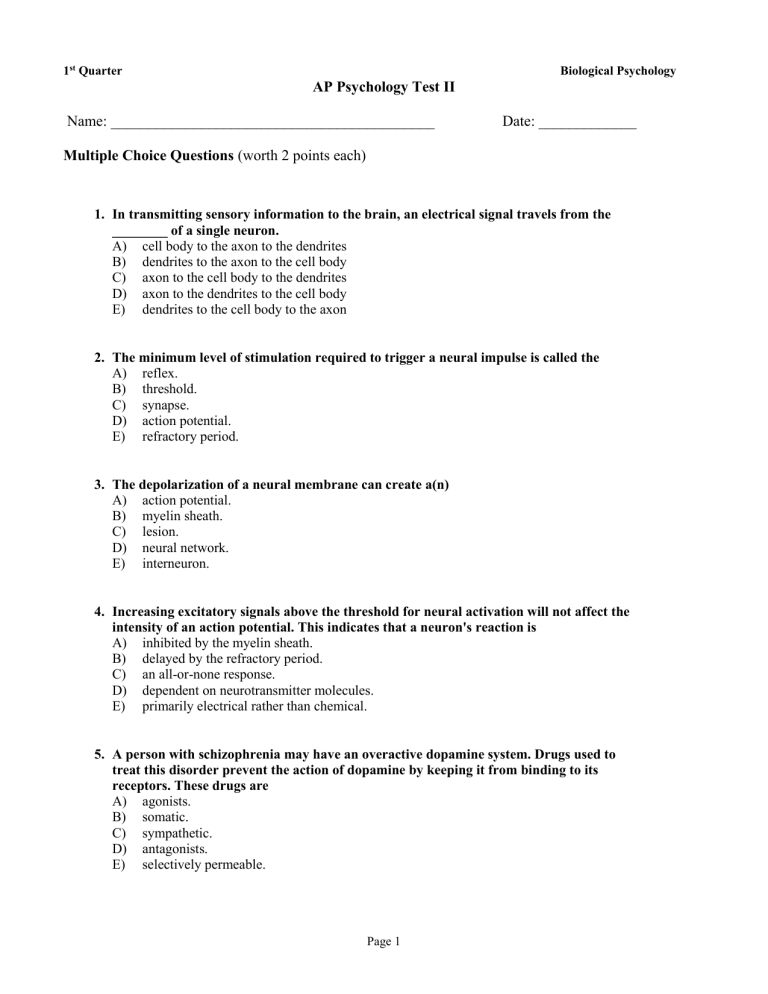
1 st Quarter
AP Psychology Test II
Biological Psychology
Name: ___________________________________________ Date: _____________
Multiple Choice Questions (worth 2 points each)
1. In transmitting sensory information to the brain, an electrical signal travels from the
________ of a single neuron.
A) cell body to the axon to the dendrites
B) dendrites to the axon to the cell body
C) axon to the cell body to the dendrites
D) axon to the dendrites to the cell body
E) dendrites to the cell body to the axon
2. The minimum level of stimulation required to trigger a neural impulse is called the
A) reflex.
B) threshold.
C) synapse.
D) action potential.
E) refractory period.
3. The depolarization of a neural membrane can create a(n)
A) action potential.
B) myelin sheath.
C) lesion.
D) neural network.
E) interneuron.
4. Increasing excitatory signals above the threshold for neural activation will not affect the intensity of an action potential. This indicates that a neuron's reaction is
A) inhibited by the myelin sheath.
B) delayed by the refractory period.
C) an all-or-none response.
D) dependent on neurotransmitter molecules.
E) primarily electrical rather than chemical.
5. A person with schizophrenia may have an overactive dopamine system. Drugs used to treat this disorder prevent the action of dopamine by keeping it from binding to its receptors. These drugs are
A) agonists.
B) somatic.
C) sympathetic.
D) antagonists.
E) selectively permeable.
Page 1
6. Prozac, a drug commonly prescribed to treat depression, prevents the sending neuron from taking in excess serotonin. Which process does this drug prevent from taking place?
A) depolarization
B) reuptake
C) the all-or-none response
D) an action potential
E) a refractory period
7. Migraine headaches are most closely linked with an
A) oversupply of GABA.
B) undersupply of serotonin.
C) undersupply of norepinepherine.
D) undersupply of acetylcholine.
E) oversupply of glutamate.
8. Nerves are neural cables containing many
A) hormones.
B) endorphins.
C) interneurons.
D) axons.
E) lesions.
9. As you are reading this question, the cells in your eyes are firing in response to the light coming from this paper. Which type of neuron is carrying this message to the brain?
A) interneuron
B) sensory
C) presynaptic
D) motor
E) efferent
10. An accelerated heartbeat is to a slowed heartbeat as the ________ nervous system is to the
________ nervous system.
A) somatic; autonomic
B) autonomic; somatic
C) central; peripheral
D) sympathetic; parasympathetic
E) parasympathetic; sympathetic
11. EEG is to CAT scan as:
A) amplified recording of brain waves is to recording glucose consumption.
B) x-ray photography is to amplified recording of brain waves.
C) amplified recording of brain waves is to magnetic resonance imaging.
D) recording of brain structure is to recording of brain function.
E) recording of brain function is to recording of brain structure.
Page 2
12. The concentration of glucose in active regions of the brain underlies the usefulness of a(n)
A) MRI.
B) brain lesion.
C) EEG.
D) PET scan.
E) hemispherectomy.
13. The sequence of brain regions from the evolutionarily oldest to newest is
A) limbic system; brainstem; cerebral cortex.
B) brainstem; cerebral cortex; limbic system.
C) limbic system; cerebral cortex; brainstem.
D) cerebral cortex; brainstem; limbic system.
E) brainstem; limbic system; cerebral cortex.
14. The medulla is to the control of ________ as the cerebellum is to the control of ________.
A) eating; sleeping
B) breathing; walking
C) emotion; motivation
D) memory; attention
E) hearing; seeing
15. Your life would be most immediately threatened if you suffered destruction of the
A) amygdala.
B) hippocampus.
C) angular gyrus.
D) corpus callosum.
E) medulla.
16. Severing a cat's reticular formation from higher brain regions causes the cat to
A) become violently aggressive.
B) cower in fear.
C) experience convulsive seizures.
D) lapse into a coma.
E) taste delicious.
17. Which brain structure receives information from all the senses except smell?
A) hippocampus
B) amygdala
C) pons
D) thalamus
E) medulla.
Page 3
18. The brain structure that provides a major link between the nervous system and the endocrine system is the
A) cerebellum.
B) amygdala.
C) reticular formation.
D) hypothalamus.
E) medulla.
19. Which of the following is the component of the limbic system that plays an essential role in the processing of new memories?
A) hypothalamus
B) thalamus
C) hippocampus
D) medulla
E) cerebellum
20. Which neural center in the limbic system plays a central role in emotions such as aggression and fear?
A) amygdala
B) thalamus
C) cerebellum
D) medulla
E) dendrite
21. Olds and Milner located reward centers in the brain structure known as the:
A) sensory cortex.
B) hypothalamus.
C) cerebellum.
D) medulla.
E) amygdala.
22. A patient who suffered a stroke says that she no longer recognizes herself in a mirror.
Which brain structure was likely damaged in the stroke?
A) the left hippocampus
B) fusiform gyrus in the right temporal lobe
C) somatosensory cortex
D) angular gyrus in the left occiptial lobe
E) Broca's area in the left frontal lobe
23. Neurosurgeons have severed the corpus callosum in human patients in order to reduce:
A) aphasia.
B) epileptic seizures.
C) depression.
D) neural plasticity.
E) reward deficiency syndrome.
Page 4
24. If a teacher accused you of cheating on a test, your adrenal glands would probably release
________ into your bloodstream.
A) endorphins
B) acetylcholine
C) seratonin
D) epinephrine
E) insulin
25. After Karl's serious motorcycle accident, doctors detected damage to his cerebellum. Karl is most likely to have difficulty
A) experiencing intense emotions.
B) reading printed words.
C) understanding what others are saying.
D) tasting the flavors of foods.
E) playing his guitar.
26. In 1861, Paul Broca studied a stroke patient he called “Tan.” He was called this because as a result of brain damage it was the only word he could pronounce. Based on Broca's early work, which of the following brain regions is involved in speech production?
A) angular gyrus
B) left temporal lobe
C) sensory cortex
D) left frontal lobe
E) auditory cortex
27. The occipital lobes are to ________ as the temporal lobes are to ________.
A) hearing; sensing movement
B) seeing; sensing touch
C) sensing pleasure; sensing pain
D) speaking; hearing
E) seeing; hearing
28. An area at the rear of the frontal lobes that controls voluntary movements is called the:
A) angular gyrus.
B) hypothalamus.
C) motor cortex.
D) reticular formation.
E) frontal association area.
29. Which lobes of the brain receive the input that enables you to feel someone scratching your back?
A) parietal
B) temporal
C) occipital
D) frontal
E) cerebral.
Page 5
30. A PET scan of a patient looking at a photograph of a painting would most likely indicate high levels of activity in which brain structure?
A) sensory cortex
B) Broca's area
C) corpus callosum
D) occipital lobes
E) frontal lobes
31. In 1848, Phineas Gage, a railroad construction foreman, survived when an explosion drove an iron rod through his head. The once friendly, soft-spoken Gage became irritable and dishonest. Gage's case provided evidence that which region of the brain plays a role in personality and behavior?
A) temporal lobes
B) sensory cortex
C) frontal lobes
D) parietal lobes
E) Broca's area
32. Our lips are more sensitive than our knees to sensations of touch due to which of the following?
A) More neurotransmitters are released when the lips are touched.
B) A larger area of the sensory cortex is associated with our lips.
C) The dendrites connected to the lips are especially sensitive.
D) The medulla routes impulses from the lips directly to our brainstem.
E) Our lips are directly connected to the sensory cortex, but our knees are not.
33. Due to an automobile accident, Jenny suffered damage to her cerebral cortex in Broca's area. Jenny is most likely to experience:
A) auditory hallucinations.
B) memory loss.
C) aphasia.
D) paralysis of her left limbs.
E) reward deficiency syndrome.
34. After Rick's serious snow-skiing accident, doctors detected damage to his temporal lobe in
Wernicke's area. Because of the damage, Rick is most likely to experience difficulty in:
A) remembering past events.
B) pronouncing words correctly.
C) planning for future events.
D) recognizing familiar faces.
E) understanding what others are saying.
Page 6
35. Three-year-old Matt suffered damage to the speech area of the brain's left hemisphere when he fell from a swing. Research suggests that:
A) he will never speak again.
B) his motor abilities may improve so that he can easily use sign language.
C) he will start to speak only in a foreign language.
D) his earlier experience with speech may enable him to continue speaking.
E) his right hemisphere may take over much of the language function.
36. If a blind person uses one finger to read Braille, the brain area dedicated to that finger expands as the sense of touch invades the visual cortex. This is an example of
A) brain plasticity.
B) hemispheric specialization.
C) neural prosthetics.
D) integrated association areas.
E) aphasia.
37. A picture of a dog is briefly flashed in the left visual field of a split-brain patient. At the same time a picture of a boy is flashed in the right visual field. In identifying what she saw, the patient would be most likely to
A) use her right hand to point to a picture of a dog.
B) verbally report that she saw a dog.
C) use her left hand to point to a picture of a cat.
D) verbally report that she saw a boy.
E) communicate that she saw a picture of a boy with a dog.
38. Neurosurgeons have severed the corpus callosum in human patients in order to reduce
A) aphasia.
B) epileptic seizures.
C) depression.
D) neural plasticity.
E) reward deficiency syndrome.
39. Psychologist Michael Gazzaniga asked split-brain patients to stare at a dot as he flashed
HE·ART on a screen. HE appeared in the left visual field, ART in the right. When asked to point to the word with their left hand, patients pointed to
A) HE.
B) ART.
C) HEART.
D) EA.
E) nothing. They were unable to complete the task.
40. Research with split-brain patients led Michael Gazzaniga to conclude that the ________ typically constructs the theories people offer to explain their own behaviors.
A) autonomic nervous systems
B) left cerebral hemisphere
C) somatic nervous systems
D) right cerebral hemisphere
E) hypothalamus
Page 7
41. A failure to recognize that one's arm or leg is part of one's self is most likely to be associated with damage to the
A) amygdala.
B) hypothalamus.
C) right hemisphere.
D) sympathetic nervous system.
E) left hemisphere.
42. The localization of a function such as speech production to the right or left side of the brain is called
A) neurogenesis.
B) reticular formation.
C) hemispherectomy.
D) plasticity.
E) lateralization.
43. The benefits of brain plasticity are most clearly demonstrated in
A) children who have had a cerebral hemisphere surgically removed.
B) people paralyzed by a severed spinal cord.
C) individuals with Alzheimer's disease.
D) adults with aphasia.
E) people free of any disease or brain damage.
44. Evolutionary psychologists emphasize that environmentally adaptive behaviors are those that have promoted
A) reproductive success.
B) personal happiness.
C) cultural diversity.
D) heritability.
E) behavior genetics.
45. Evolutionary psychologists would be most likely to attribute gender differences in attitudes toward sex to the fact that men have ________ than do women.
A) larger bodies
B) stronger personalities
C) a weaker sense of empathy
D) greater reproductive potential
E) more insecurities
46. Researchers found that women rated men higher as potential long-term mates when they spent more time looking at baby pictures. This finding suggests that
A) women are drawn to youthful, healthy appearing men.
B) women prefer men who express interest in caring for joint offspring.
C) men approach sex as being more relational.
D) women have a lower threshold for perceiving warm responses as sexual.
E) men are less attracted to women who are likely to reproduce.
Page 8
47. Evolutionary psychologists are most likely to be criticized for
A) providing hindsight explanations for human behaviors.
B) failing to consider unconscious motivations.
C) overemphasizing humans' capacity to learn and adapt to a variety of environments.
D) underestimating gender differences in mate selection.
E) overestimating cultural differences in human sexual behaviors.
48. When people discuss the “nature vs. nurture” controversy, Nature refers to ________ and
Nurture refers to ________.
A) genes; heredity
B) chromosomes; genetics
C) biology; environment
D) DNA; hormones
E) thinking; behavior
49. The study of the relative power and limits of genetic and environmental influences on behavior and personality traits is known as
A) molecular genetics.
B) evolutionary psychology.
C) behavior genetics.
D) natural selection.
E) genome research.
50. Heritability refers to the extent to which
A) unrelated individuals share common genes.
B) genetic mutations can be transmitted to one's offspring.
C) trait differences among individuals are attributable to genetic variations.
D) adult personality is determined by infant personality.
E) nurture controls a trait rather than nature.
Page 9
16. D
17. D
18. D
19. C
20. A
21. B
22. B
23. B
24. D
25. E
26. D
27. E
28. C
29. A
30. D
31. C
32. B
33. C
34. E
35. E
36. A
37. D
38. B
39. A
40. B
41. C
42. E
43. A
44. A
45. D
46. B
47. A
48. C
49. C
50. C
Answer Key
9. B
10. D
11. E
12. D
13. E
14. B
15. E
1. E
2. B
3. A
4. C
5. D
6. B
7. E
8. D
Page 10
